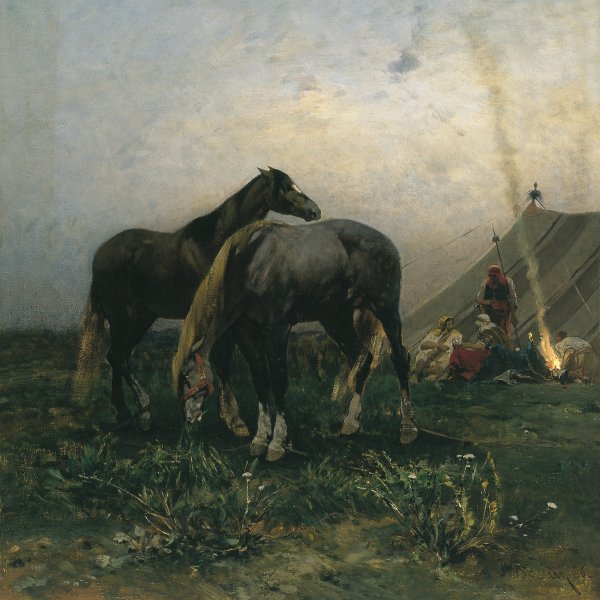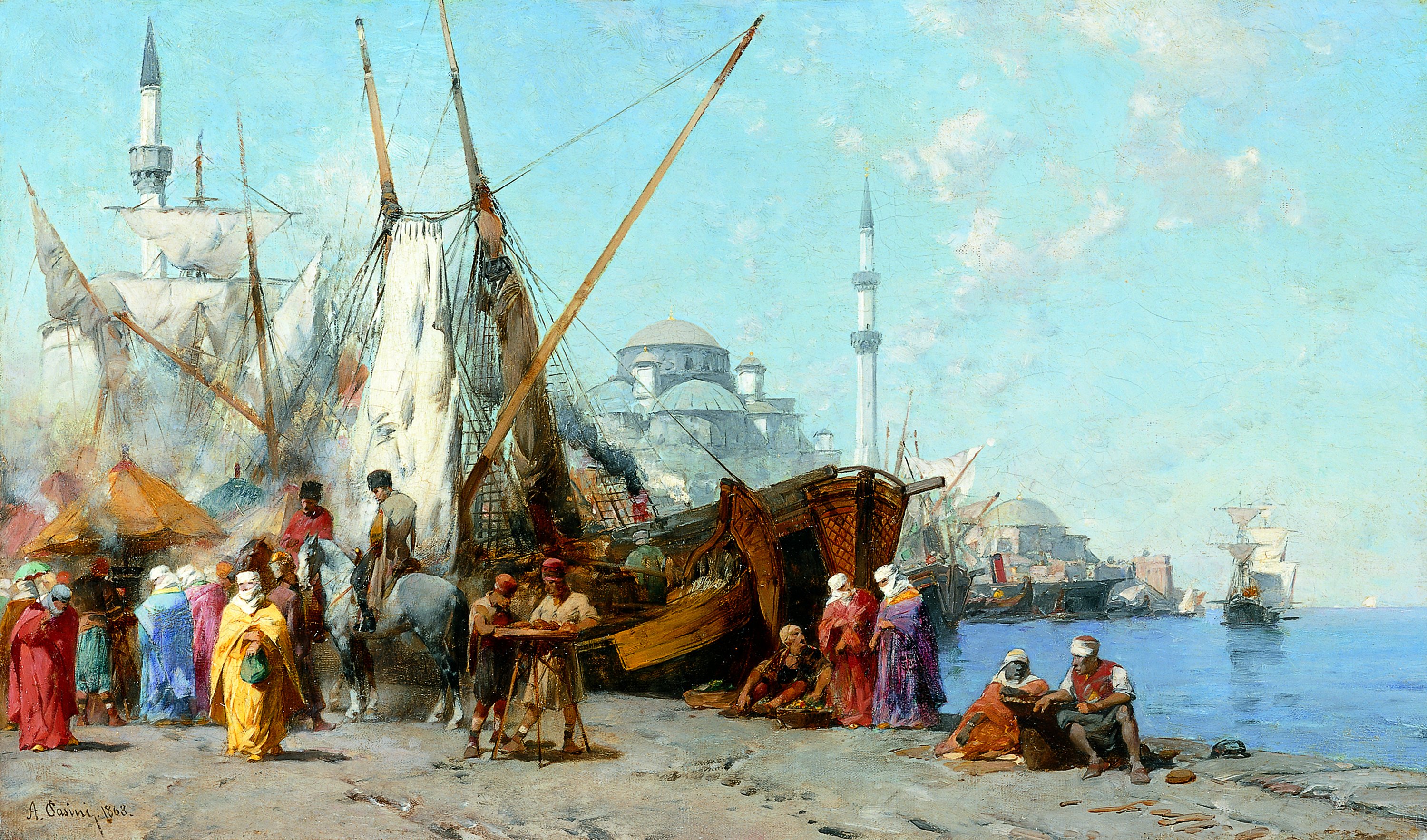Market in Constantinople
1868
Oil on canvas.
23.5 x 40 cm
Carmen Thyssen Collection
Inv. no. (
CTB.1997.18
)
Not exhibited
Level 2
Permanent Collection
Level 1
Permanent Collection
Level 0
Carmen Thyssen Collection and Temporary exhibition rooms
Level -1
Temporary exhibition rooms, Conference room and EducaThyssen Studio
This small but fascinating oil gathers all the elements of Alberto Pasini's favourite theme, here expressed with an elegance and bright luminarism that produce a striking effect.
The painting, signed and dated in 1868 (it is therefore part of the series of studies made by the artist in Constantinople between 1867 and 1869) represents a scene crowded with figures close to some moored boats loaded with goods and with limp sails, the sea and the unfailing Yeni Djami mosque.
The boats, represented in the Bosporus strait and depicted with a more concise technique than the very meticulous one used in other of his studies, their reflection in the water, the criss-cross of masts, of rope ladders and of the falls of the furled sails, all produce a lively scene which clearly stands out against the mosque and the sky in the background.
The spontaneous, almost sketchlike, technique is precise and polished, as if the picture had been painted en plein air. The atmospheric effects are either crystal-clear or soft, painted in pearly grey tones, which blend with the sky and the distant horizon. They are interrupted here and there by the reds and yellows of the women's dresses, which liven up the scene of the crowd in the foreground, immersed in a greyish pink cloud of dust.
All this is in perfect consonance with the practice of painting from nature, a common method used by this master since he returned to Paris from Persia in 1856.
For Pasini, who was a skilled draughtsman, as noted by Giuseppe Boccaccio and Girolamo Magnani, his painting and scenography masters at the Academy in Parma (he also studied lithography under Paolo Toschi), painting from life was never merely documentary, and was accompanied from the beginning by an admirable technique and by the choice of picturesque, but not unoriginal, oriental subjects.
However, it was in 1868, on the occasion of a new trip, this time to Turkey, that a crucial event for his art and his future fame took place: his encounter with Istanbul.
The city of Constantinople, with its busy life, its strong, particular, vibrating light which outlines the volumes of the buildings and the figures, became a recurring theme in Pasini's art, a subject dealt with several times, but always with a renewed fantasy, from various points of view and representing different scenes.
This painting can be compared with oils such as On the Banks of the Golden Horn of 1869, belonging to the collection of Count Gaetano Marzotto; Market at the Golden Horn, of 1868; The Port of Constantinople, also of 1868, with the same boats on the left; Market at Yeni Djami of 1869 and Oriental Scene - Market at the Port also of 1869, belonging to private collections and published in 1991. All these works include views of the port, the grandiose domes of the mosque in the background, the onlookers haggling and the horsemen riding splendid animals with shiny coats.
Pasini made many drawings and oils depicting the Islamic temple on the banks of the Golden Horn, such as the painting entitled Yeni Djami (1867-1868) kept in the Museo Civico of his native town Busseto, in which the beautiful building is the only protagonist of the composition.
Here we can clearly see the result of the immense heritage of memories constituted by the corpus of sketchbooks and by the splendid, bright drawings from nature now kept in the Drawings and Prints Cabinet at the Uffizi in Florence, and in many private collections.
Giovanni Godi
The painting, signed and dated in 1868 (it is therefore part of the series of studies made by the artist in Constantinople between 1867 and 1869) represents a scene crowded with figures close to some moored boats loaded with goods and with limp sails, the sea and the unfailing Yeni Djami mosque.
The boats, represented in the Bosporus strait and depicted with a more concise technique than the very meticulous one used in other of his studies, their reflection in the water, the criss-cross of masts, of rope ladders and of the falls of the furled sails, all produce a lively scene which clearly stands out against the mosque and the sky in the background.
The spontaneous, almost sketchlike, technique is precise and polished, as if the picture had been painted en plein air. The atmospheric effects are either crystal-clear or soft, painted in pearly grey tones, which blend with the sky and the distant horizon. They are interrupted here and there by the reds and yellows of the women's dresses, which liven up the scene of the crowd in the foreground, immersed in a greyish pink cloud of dust.
All this is in perfect consonance with the practice of painting from nature, a common method used by this master since he returned to Paris from Persia in 1856.
For Pasini, who was a skilled draughtsman, as noted by Giuseppe Boccaccio and Girolamo Magnani, his painting and scenography masters at the Academy in Parma (he also studied lithography under Paolo Toschi), painting from life was never merely documentary, and was accompanied from the beginning by an admirable technique and by the choice of picturesque, but not unoriginal, oriental subjects.
However, it was in 1868, on the occasion of a new trip, this time to Turkey, that a crucial event for his art and his future fame took place: his encounter with Istanbul.
The city of Constantinople, with its busy life, its strong, particular, vibrating light which outlines the volumes of the buildings and the figures, became a recurring theme in Pasini's art, a subject dealt with several times, but always with a renewed fantasy, from various points of view and representing different scenes.
This painting can be compared with oils such as On the Banks of the Golden Horn of 1869, belonging to the collection of Count Gaetano Marzotto; Market at the Golden Horn, of 1868; The Port of Constantinople, also of 1868, with the same boats on the left; Market at Yeni Djami of 1869 and Oriental Scene - Market at the Port also of 1869, belonging to private collections and published in 1991. All these works include views of the port, the grandiose domes of the mosque in the background, the onlookers haggling and the horsemen riding splendid animals with shiny coats.
Pasini made many drawings and oils depicting the Islamic temple on the banks of the Golden Horn, such as the painting entitled Yeni Djami (1867-1868) kept in the Museo Civico of his native town Busseto, in which the beautiful building is the only protagonist of the composition.
Here we can clearly see the result of the immense heritage of memories constituted by the corpus of sketchbooks and by the splendid, bright drawings from nature now kept in the Drawings and Prints Cabinet at the Uffizi in Florence, and in many private collections.
Giovanni Godi






